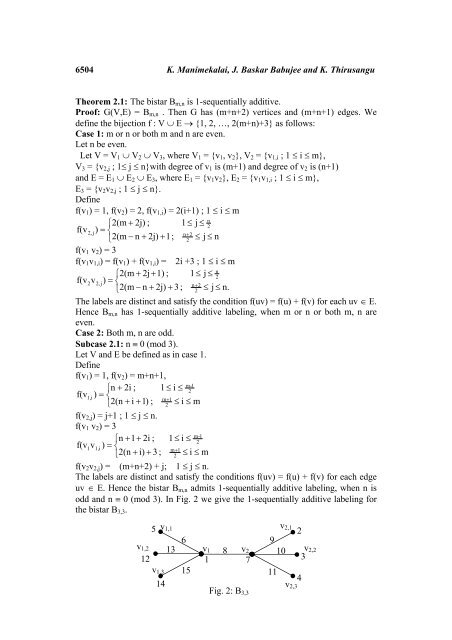Simply Sequentially Additive Labeling of Some Special Trees
Simply Sequentially Additive Labeling of Some Special Trees
Simply Sequentially Additive Labeling of Some Special Trees
Create successful ePaper yourself
Turn your PDF publications into a flip-book with our unique Google optimized e-Paper software.
6504 K. Manimekalai, J. Baskar Babujee and K. Thirusangu<br />
Theorem 2.1: The bistar Bm,n is 1-sequentially additive.<br />
Pro<strong>of</strong>: G(V,E) = Bm,n . Then G has (m+n+2) vertices and (m+n+1) edges. We<br />
define the bijection f : V ∪ E → {1, 2, …, 2(m+n)+3} as follows:<br />
Case 1: m or n or both m and n are even.<br />
Let n be even.<br />
Let V = V1 ∪ V2 ∪ V3, where V1 = {v1, v2}, V2 = {v1,i ; 1 ≤ i ≤ m},<br />
V3 = {v2,j ; 1≤ j ≤ n}with degree <strong>of</strong> v1 is (m+1) and degree <strong>of</strong> v2 is (n+1)<br />
and E = E1 ∪ E2 ∪ E3, where E1 = {v1v2}, E2 = {v1v1,i ; 1 ≤ i ≤ m},<br />
E3 = {v2v2,j ; 1 ≤ j ≤ n}.<br />
Define<br />
f(v1) = 1, f(v2) = 2, f(v1,i) = 2(i+1) ; 1 ≤ i ≤ m<br />
n<br />
⎧2(m<br />
+ 2j) ; 1 ≤ j ≤ 2<br />
f(v2,<br />
j)<br />
= ⎨<br />
n+<br />
2<br />
⎩2(m<br />
− n + 2j) + 1;<br />
2 ≤ j ≤ n<br />
f(v1 v2) = 3<br />
f(v1v1,i) = f(v1) + f(v1,i) = 2i +3 ; 1 ≤ i ≤ m<br />
⎧2(m<br />
+ 2j+<br />
1) ; 1≤<br />
j ≤<br />
f(v v ) = ⎨<br />
+<br />
⎩2(m<br />
− n + 2j) + 3 ; 2 ≤ j ≤ n.<br />
2 n<br />
n<br />
2<br />
2 2, j<br />
The labels are distinct and satisfy the condition f(uv) = f(u) + f(v) for each uv ∈ E.<br />
Hence Bm,n has 1-sequentially additive labeling, when m or n or both m, n are<br />
even.<br />
Case 2: Both m, n are odd.<br />
Subcase 2.1: n ≡ 0 (mod 3).<br />
Let V and E be defined as in case 1.<br />
Define<br />
f(v1) = 1, f(v2) = m+n+1,<br />
m-1<br />
⎧n<br />
+ 2i ; 1 ≤ i ≤ 2<br />
f(v1,<br />
i ) = ⎨<br />
m+<br />
1<br />
⎩2(n<br />
+ i + 1)<br />
; 2 ≤ i ≤ m<br />
f(v2,j) = j+1 ; 1 ≤ j ≤ n.<br />
f(v1 v2) = 3<br />
m-1<br />
⎧n<br />
+ 1+<br />
2i ; 1 ≤ i ≤ 2<br />
f(v1<br />
v1,<br />
i ) = ⎨<br />
m+<br />
1<br />
⎩2(n<br />
+ i) + 3 ; 2 ≤ i ≤ m<br />
f(v2v2,j) = (m+n+2) + j; 1 ≤ j ≤ n.<br />
The labels are distinct and satisfy the conditions f(uv) = f(u) + f(v) for each edge<br />
uv ∈ E. Hence the bistar Bm,n admits 1-sequentially additive labeling, when n is<br />
odd and n ≡ 0 (mod 3). In Fig. 2 we give the 1-sequentially additive labeling for<br />
the bistar B3,3.<br />
v1,2<br />
12<br />
5<br />
v1,3<br />
v1,1<br />
14<br />
13<br />
6<br />
15<br />
v1 8<br />
v2<br />
1 7<br />
Fig. 2: B3,3<br />
9<br />
10<br />
11<br />
v2,1<br />
2<br />
v2,3 4<br />
3<br />
v2,2
















